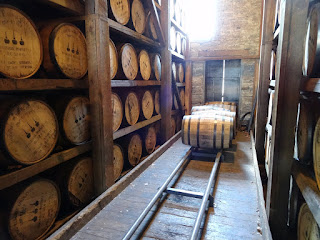In order to break up the drive down to the Smoky Mountains, and to enjoy the food and drink offerings of Kentucky, Alyssa and I stayed a few nights in Louisville. We had a blast, a really fun, mid-size city with alot going on.
On our second day we decided to drive about an hour south towards Nashville to check out Mammoth Cave National Park. It's known to be the longest cave system in the world, our park guide told us there were about 25 known entrances to the cave, about half of which had been created with dynamite. There's so much history in the caves, I can't go into detail here, but I will say if you're in the area, the park is a must see.
Here are a few shots of the cave:
So we enjoyed the cave tour, it was a warm day and it was nice to descend into the earth and relax in the cool, damp air.
What I didn't know, was that a stroll we would take afterwards on a 2km loop trail would turn out to be some the best botanizing I've ever experienced! I guess it's all relative, what's common to Kentucky versus Ontario, but the stuff we were seeing every few steps, holy mackerel!
Stonecrop (Sedum ternatum)
I'm a sucker for Maidenhair Fern (Adiantum pedatum)
The main entrance to Mammoth Cave, down at the mouth of the cave the air was probably 10°C and a notable breeze exiting the cave.
Pawpaw (Asimina triloba) in full bloom, some sections of trail were just lined with flowering stems. I've always found it interesting that it flowers almost completely before leaf-out.
Broad Beech Fern (Phegopteris hexagonoptera)
My first wild Ohio Buckeye (Aesculus glabra)
The orchid-like flower of Ohio Buckeye. Niiice.
Walking Fern (Asplenium rhizophyllum), a neat fern which sets root from the tips of the fronds, thus "walking" over rock faces.
Alyssa: "Hey what's this yellow flower over here?"
Me: "Oh $#!+"
Wood Poppy (Stylophorum diphyllum). In Ontario there are 3 known populations in and around London and Ilderton, a couple years back I counted maybe 400 at one of the populations. Very cool to stumble upon it here.
Star Chickweed (Stellaria pubera)
Dwarf Larkspur (Delphinium tricorne).
River Cane (Arundinaria gigantea) A native bamboo was definitely not on my radar when we started this hike! There are 2 other species found in the southeastern US, predominantly the in the Carolinas.
Pipevine Swallowtail (Battus philenor), I bounded through a tonne of muddy Sycamore floodplain chasing this one down before it finally stopped briefly.
Wingstem (Verbesina alternifolia) wasn't yet in flower but I grabbed a photo of the distinctive stems.
Sure, why not through in some Harbinger-of-spring (Erigenia bulbosa). This member of the carrot family is uncommon in Ontario and one of the first blooms come spring. I sometimes wonder if it's just under-reported, being 5-10cm tall and blooming when very few people are out looking at wildflowers.
Twinleaf (Jeffersonia diphylla)
Virginia Iris (Iris virginica)
The muddy waters of the Green River.
Hey what other Ontario rarities have we not seen yet today?
Green Violet (Hybanthus concolor) Bam!
Fire Pink (Silene virginica) was an eye catcher, especially perched on rock faces like this one. I have Royal Catchfly (Silene regia) in my garden that is loving the rain we're getting right now.
Another one not on my radar at all, American Columbo (Frasera caroliniensis). This Ontario rarity is found in and around Hamilton and Brantford area. There are about a dozen species of Frasera, this is the only one occurring in eastern North America.
We lucked out and found a flowering stalk. I know for many of the populations in Ontario you see very few basal rosettes go to flower each year, form one population I visit annually you might expect 5% to bloom. I believe the plants live/bloom in a cycle that runs about 7 years.
Carolina Vetch (Vicia caroliniana)
And we can't forget the Eastern Flowering Dogwood (Cornus florida) which dappled the slopes in white. With this song in mind, I don't know how many times I sang "Pickin' me a boo-kay a dogwood flowers".
A Luna Moth (Actias luna) I spotted basking on a wall.
A few photos of a side trip we made to the Woodford Reserve bourbon distillery. The limestone buildings were beautifully constructed, and the bourbon wasn't half bad either!
Fermenter tanks made of Kentucky's state tree, Tulip Tree (Liriodendron tulipifera).
Barrels stored in one of the rack houses.



































No comments:
Post a Comment